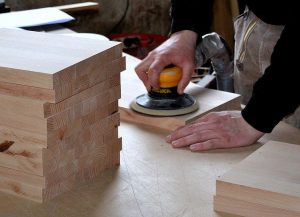
Woodworking projects often involve connecting two wooden workpieces together. While glue or adhesives may sometimes be used, most wooden workpieces are connected via a joint. A joint is a natural connection where the ends of two wooden workpieces meet. It’s designed to hold the wooden workpieces together, thus eliminating the need for glue or adhesives. What are the most common types of woodworking joints?
#1) Butt Joint
While relatively weak, the butt joint is a common type of woodworking joint. It consists of two wooden workpieces that are fitted at a right angle. One of the wooden workpieces is “butted” against the other wooden workpieces. The butt joint doesn’t offer the same level of strength as other woodworking joints, but its simple and easy to create.
#2) Dowel Joint
Some woodworking joints require the use of dowels. Known as a dowel joint, it’s often used in furniture. With a dowel joint, the ends of two wooden workpieces are constructed with one or more hollow tubes. These tubes are designed to support a dowel pin. Dowel joints are typically used in conjunction with a butt joint. The wooden workpieces are jointed at a right angle, after which they are reinforced with one or more dowel pins.
#3) Box Joint
Another common type of woodworking joint is a box joint. Box joints are characterized by their interlocking design. The ends of the wooden pieces are constructed with teeth that interlock together. Box joints are stronger than butt joints. With their interlocking teeth, they create a stronger connection between the joined workpieces.
#4) Bridle Joint
Also known as a tongue-and-fork joint, a bridle joint is a more complex type of woodworking joint. With a bridle joint, the end of one wooden workpiece is designed with an opening that supports the notched end of the other workpiece. Bridle joints are typically used for sloped beams and rafters.
#5) Mortise-and-Tenon Joint
A mortise-and-tenon joint is a popular type of joint for woodworking projects. It receives its namesake from its use of a mortise and tenon. A mortise is an opening that supports a notched end known as a tenon. Mortise-and-tenon joints are strong and long-lasting. You can find them in furniture, cabinets, doors and windows.
#6) Lap Joint
Finally, a lap joint is a type of woodworking joint that requires the placement of a wooden workpiece over another workpiece. With a lap joint, the ends of the wooden workpieces are designed with alternating patterns. Some of them have a half lap pattern, whereas others have a cross lap or dovetail lap pattern. Regardless, one end is placed inside the other end.
No tags for this post.